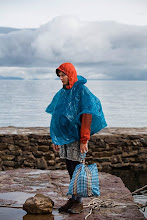A brutal eight our bus ride from Potosi on mostly single wide dirt roads we finally reached the nothing special town of uyuni. The bus ride was unbelievably bad, with a huge portion of the road still under construction and the remainder primarily washboard that seemed to never end. Luckily we had the front seats, which were significantly less dusty, bumpy, and noisy, but blasted by the sun. Despite the unbearable quality of the roads, the trip was probably through the most beautiful country side we had seen thus far. We saw more llamas on that ride then we saw on the rest of our travels combined and passed through surreal canyons of orange rock, white sand, and green grass…it was a wild frontier indeed with few inhabitants and vast amounts on space gorgeous mountains…the kinds of places you’d love to just get dropped off and explore.
Upon our arrival, we shopped around at the numerous tour agencies to arrange a trip to the salt flats and the various other attractions of the area. We finally settled on one the following morning and were paired up with two kiwis, a brit, and one guy from japan. We all piled into a landcruiser, the tour vehicle of choice, along with our driver “the godfather” and our cook and before we had a chance to really think things through we were on our way to the first destination, the abandoned railroad cars just outside of town.
We rolled up to a dirt parking lot along with another dozen land cruisers from different tours and it became immediately apparent how touristy our trip was about to be, and how rushed, when the driver told us we had twelve minutes to look around. There were probably thrity or so cars left to rust away out in the desert where apparently a train headed for peru and a train headed for chile collided a number of years back. The place was pretty cool in an apocalyptic sort of way, but to swarmed with tourists to get any clean shots.
From there we raced out to the salt flats with a brief stop in a little village where they gathered salt from the flats and sold touristy whatnots. It was pretty awesome once we got out onto the flats to see salt workers piling up the salt into big mounds for drying then shoveling into huge trucks to take away to sell. It was fun to walk around in the shallow water and get covered in salt. From there it was off to the salt hotel, which was made entirely of slabs of salt and was totally amazing and kitschy.
Next we headed out across the endless flats to what seemed like nowhere. It was trippy to drive across, and looked like a giant frozen lake covered in snow, and I couldn’t help but feel like we were going to break through at any moment. Some areas of the flats were covered in a thin layer of water, which made it feel like we were more in a boat then a car…it was quite bizarre, but obviously very beautiful, but blindingly bright.
The highlight of the salt flats was the cactus covered island that we drove a 100km out across the flats to reach. The rock of the island was all fossilized coral from when the flats were underwater, and the primary plant are these giant cacti that were over twenty feet tall and up to 1,500 years old. On top of that, the entire island was surrounded by nothing but white salt with huge volcanoes and snow covered mountains off in the distance. We had lunch at the island with the accompaniment of a giant emu and heaps of other tourists. After lunch everyone took pictures out on the flats playing optical tricks with size and distance which was quite entertaining to watch.
We left the island and headed off to the hills where we stayed in a small salt hotel outside a tiny village overlooking the flats. We had dinner with the group and got to know each other…turned out to be a pretty entertaining crew. That night we went to see the stars which were crazy clear given our altitude and the dryness of the environment…the stars sparkled like fireflies...and we all agreed they were the clearest skies we’d ever scene…completely magical.
We got up at sunrise the following morning and the jeep ride began….out across salt flats, past active volcanoes, rainbow colored mineral mountain ranges, and huge barren valleys with zero foliage…it was very surreal…like driving out across mars or something….with just about as much oxygen at our record 15,000 feet. There were giant rocks out in the middle of know where, wild pecunians running about, bazaar moss looking coral like blimpy green something growing on the rocks, massive lave flows, multicolored lagoons filled with pink flamingos, geysers, hotsprings, snow peaked mountains, and three days of the worst roads ive ever endured. We off roaded something like 500km in three days, all the way south to the border of chile where we dropped off some passengers, looping back up through the unbelievable landscapes past frontier towns, borax mines, and the most amazing maze of lava flow ever. It was completely unbelievable and abusive and exhausting…spring got altitude sickness pretty bad, as well as I, along with food poisoning and fevers…it was an experience for sure…something to remember and something to be so happy to be over with. Go! But be warned…and get a really good jeep and safe driver!





















































